Thailand’s temples are among the most dazzling in the world, with their pearly white stupas and shimmering gold chaityas. But a few years ago I was up in northern Thailand in a low-slung Burmese-style wooden temple, thinking that it was far less dramatic than others I had seen. Then, I noticed what I had come for: the brightly colored panels of painted glass in a corner of the temple that depicted the life of the Buddha.
I was looking for one set of panels in particular, wondering if some of those small framed paintings would stand out—they had been painted not by Burmese monks more than two centuries ago like the others, but by my friend Judy Jensen. Judy is an Austin artist who had come to the rescue of this modest temple whose most precious relics had been damaged by an earthquake.
I had come along to Thailand to take part in two of my friend Judy’s dreams.
I had come along to Thailand with Judy and a group of her friends to take part in two of Judy’s dreams. For Judy, the first dream began with shards of broken glass in this small, out-of-the way temple. She and her husband Emil had been visiting Thailand for several years, but there was a particular town and a nearby rustic resort that had become their special place: the Fern Resort near the northern Thai town of Mae Hong Son, close to the border with Myanmar (Burma). She was particularly drawn to a nearby temple, called Wat Chong Klang, where she had first seen its collection of 19th-century Burmese reverse paintings on glass.
Judy, as it happens, is a master of reverse painting on glass, and her work has been included in private collections and museums across the U.S. Although the technique has been used to create sacred images for many centuries, there are few contemporary artists who work in this fragile medium.
Read More: Mama Mia! Women Artists Win Big at the Venice Biennale
The Thailand Earthquake
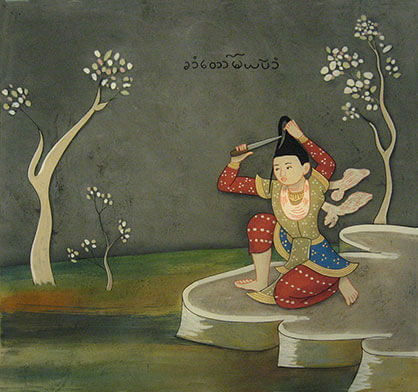
A close up of one of the reverse glass paintings Judy Jensen made to replace an 18th-century one that had been destroyed in an earthquake.
When she visited the temple in 2005, following the earthquake and tsunami that had devastated so much of the country, she was horrified to see what had happened to the paintings. Many of them had cracked or shattered from the impact of the quake. On her next visit, as she saw the damage was getting worse, she began to think about how she might use her skills to restore or replace the damaged paintings. She made a sample painting to show the temple’s Abbot, who was thrilled when he saw it.
In 2013, she launched a Kickstarter campaign to help finance the painstaking restoration of the works the Abbot had chosen for her to reproduce.
The next step was to bring her friends into the project and then into her other dream. She and Emil wanted to take friends along with them to Mae Hong Son. In 2013, she launched a Kickstarter campaign to help finance the painstaking restoration of the works the Abbot had chosen for her to reproduce, and within two years, she had completed 30 paintings.
Last year, as part of a new tourism company they created called Chillaway Travel, Judy and Emil put together a trip to their beloved temple and town. Not surprisingly, the available spaces were snapped up within a couple of days by friends—all of whom, like me, had been supporters of her Kickstarter project and who had been lured, like me, by their Thai stories of glistening temples, great food, and gracious people.
The Veil Between Heaven and Earth
In Thailand, you are never far from a temple, nor from reminders of how the sacred can infuse everyday life. The monks in their saffron robes, which you see everywhere, are woven like bright threads into the fabric of Thai life. Young men are expected to spend two months as monks after serving compulsory military service. Hung in tree branches or attached to tree trunks around the temples are sayings of mindfulness, lest you forget. I was beginning to greet strangers, as Thai people do, with the prayerful wai gesture of hands clasped together, which resembles the “Namaste” sign of prayerful respect I had learned in yoga.
Part of the ritual in visiting temples in Thailand is the removing of shoes before stepping inside the sacred space. You don’t just walk in casually; there is a sense of passing a threshold between the earthly and the heavenly. But I wasn’t really thinking about shoes when I got dressed in my modest temple-visit clothing on the morning of November 2nd, which marks the Day of the Dead in Mexico, when the departed return for a day to visit the living.
I’ve spent that day in Mexico for the past five years, and that morning I was thinking about my friends in Mexico—including the group from NextTribe in San Miguel de Allende—and about the amazing things that tend to happen on that day. I decided to wear a pair of shoes that I had brought along at the last minute on impulse, which I hadn’t worn in a good while, so I was puzzled when I felt something strange inside one of the shoes as I slipped it on. I removed the shoe and reached inside to find . . . well, my late husband’s dog tag ID. I won’t try to explain it, except that, as Judy said, the veil between heaven and earth is thin in Thailand—as it is in Mexico on that special day.
Into the Mountains
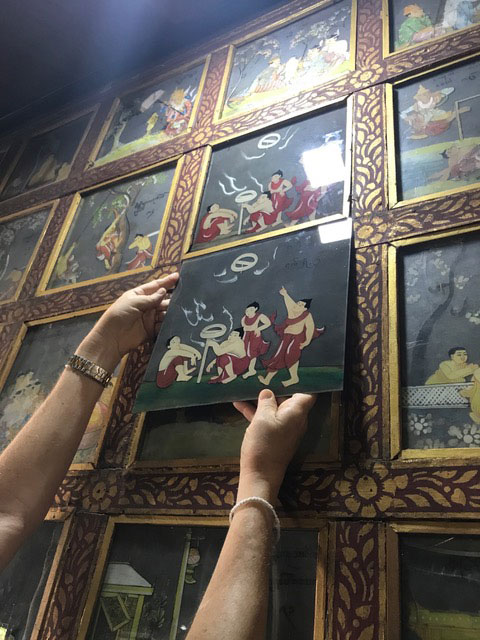
Preparing to install a new painting on the wall of images that depict the life of the Buddha.
When we arrived at the Fern Resort just outside Mae Hong Son after a long journey into the misty mountains of northern Thailand, the first thing we saw was a big sign draped across the entrance welcoming Judy and Emil and their friends. And the feeling of welcome never diminished during our time there. That night we hardly had time to settle in before going into town to join in the local Loy Krathong Festival, which occurs during a full moon in the last month of the lunar calendar.
On the banks of the town’s small lake, we bought and launched tiny candlelit floats called krathong made from banana leaves and flowers. They are said to honor the spirit of the water and to carry away worrisome burdens. Then we lit sky lanterns, small hot air balloons made of paper, that floated up like blessings into the moonlit sky, carrying our hopes and wishes.
We were eager the next morning to visit Wat Chong Klang to finally see Judy’s paintings in their sacred setting.
Following such an auspicious arrival, we were eager the next morning to visit Wat Chong Klang to finally see Judy’s paintings in their sacred setting. The temple, which had a wooden façade, was more modest and understated than the ornate and glittering temples we’d seen earlier in the trip. As we removed our shoes and entered the temple, I noticed that the large Buddha at the center was made of wicker rather than bronze. The temple’s Abbot, Judy told us, had had a dream about a wicker Buddha, and an artist had miraculously shown up to fulfill his vision.
The Life of the Buddha
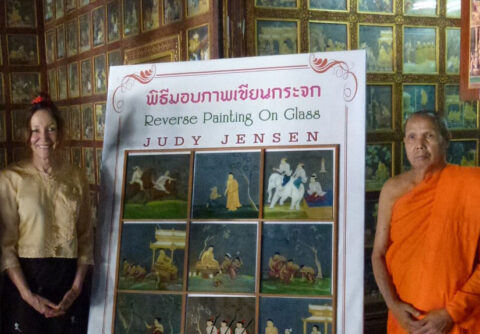
Judy Jensen with the Abbot of the Wat Chong Klang temple in Northern Thailand
Tucked in one corner of the temple were the 180 reverse-glass paintings. The best way to see them was by mounting a platform that was ordinarily used only by monks, but we had been given special dispensation to use it in order to see the paintings up close. They were simple and luminous, some in iconic stillness, others showing motion.
The paintings closest to Judy’s heart were the ones located on the bottom panel, next to the floor. They had been so completely destroyed that she had had to research their context in order to create the images. The paintings represent stories from the early life of the Buddha, in which he flees the pampered palace life he has known and encounters suffering and death as he makes his way into the world. It is that part of the Buddha’s story that I had always most related to, in which he learns the full brunt of what it is to be human and is propelled to discover a path away from suffering.
We waited breathlessly as she presented the painting to the monk. He held it carefully, as though it were an ancient relic.
Judy had brought one more painting with her to replace one she had worked on but wasn’t happy with. She felt the colors weren’t quite right. She held it up to the previous painting, and though the differences were subtle, we could see that she was clearly a perfectionist.
The young presiding monk, who had entered quietly in his bright saffron robe, greeted Judy like an old friend but with a respectful wai. We waited breathlessly as she presented the painting to the monk, and as he held it carefully, as though it were an ancient relic, we were all close to tears, as two cultures came together through art and dreams. I could imagine yet another set of paintings telling Judy’s story, of her encounter with the temple’s Abbot, who had perhaps dreamed of someone to repair the cracked paintings, just as he had dreamed about the possibility of a wicker Buddha.
Making Big Memories
That afternoon, I made the mistake of looking at my Facebook account and found a post from a friend with a link to an article claiming that research shows that when older people look back on their lives, a disproportionate number of their “big memories” happened in a very narrow window: between ages 15 and 30. I huffed and puffed in incredulity. For me, it has been just the opposite, as my most powerful experiences have come later in life.
I was still feeling indignant as we visited Wat Sam Poo Sa Ma, a rural temple complex on a hill overlooking rice paddies. There were no tourists at the site, just locals from the village who had crossed a very long bamboo footbridge to bring offerings or to buy flowers from small booths by the temple.
Despite what my friend’s Facebook post claimed, my most powerful experiences have come later in life.
A small, white baby Brahma bull, apparently a temple pet, had gotten loose and was galumphing around, getting into trouble and making everyone laugh as an elderly woman chased him away from her booth with a broom. I walked out onto a lookout terrace and sat on a folding chair, feeling utterly at peace as the incense wafted from the temple and dogs and chickens freely roamed the grounds.
As we walked down the steps from the hill and then onto the bridge, it creaked a little, and small flags fluttered as we looked out onto the partly harvested rice paddies. Judy and Emil were walking in front of me, with Judy slightly trailing Emil. As Emil turned to her, he crooked out his arm for her to take, and they continued walking together. It was one of those unrehearsed beautiful moments, and I couldn’t help but think that not only can dreams come true later in life—it is possible for someone else’s dream to become part of your own.
Read More: The Secret of Dr. Ho: A Chinese Medicine “Cure” for Anything
A version of this article was originally published in March 2018.

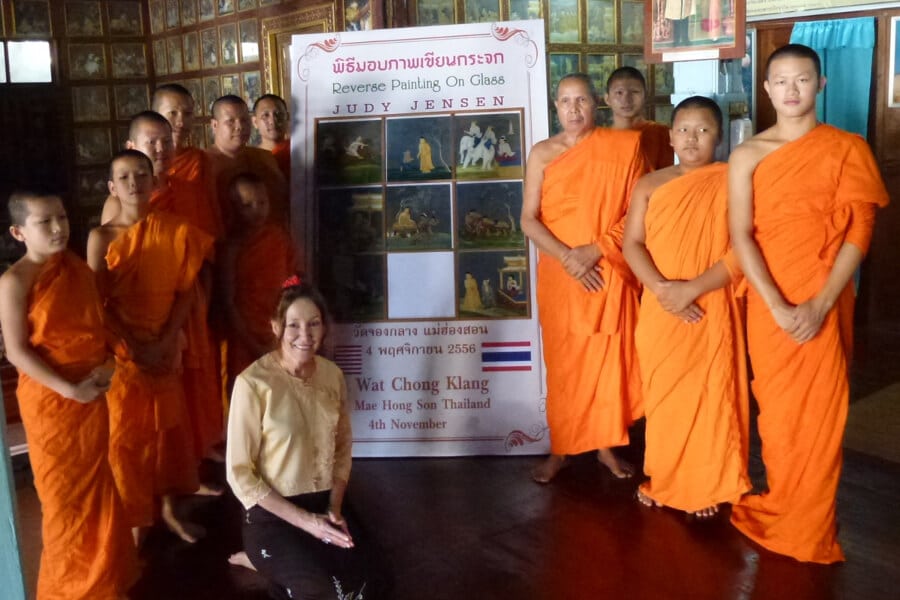
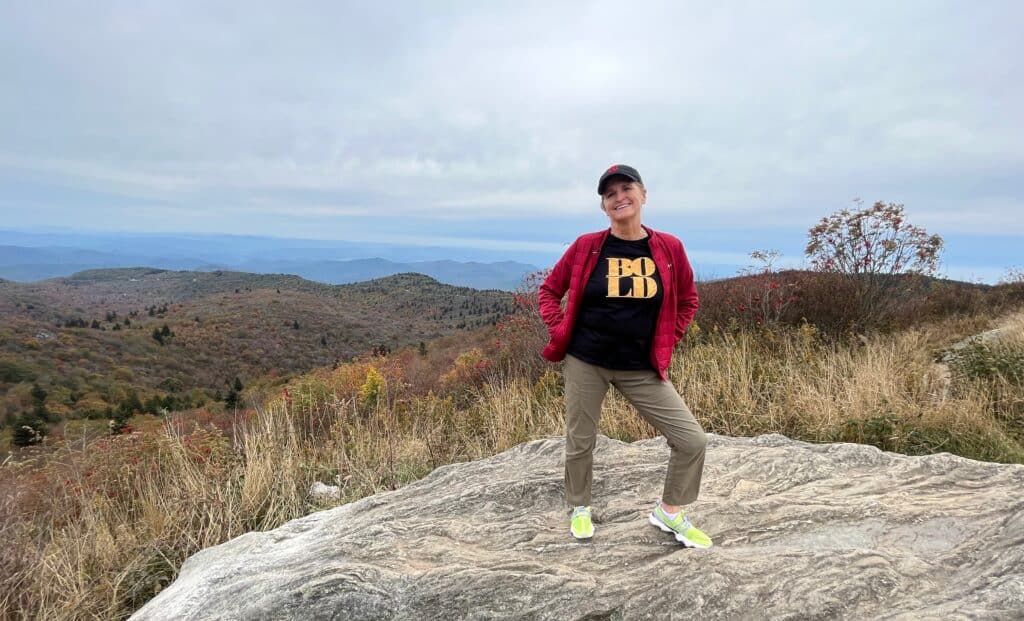














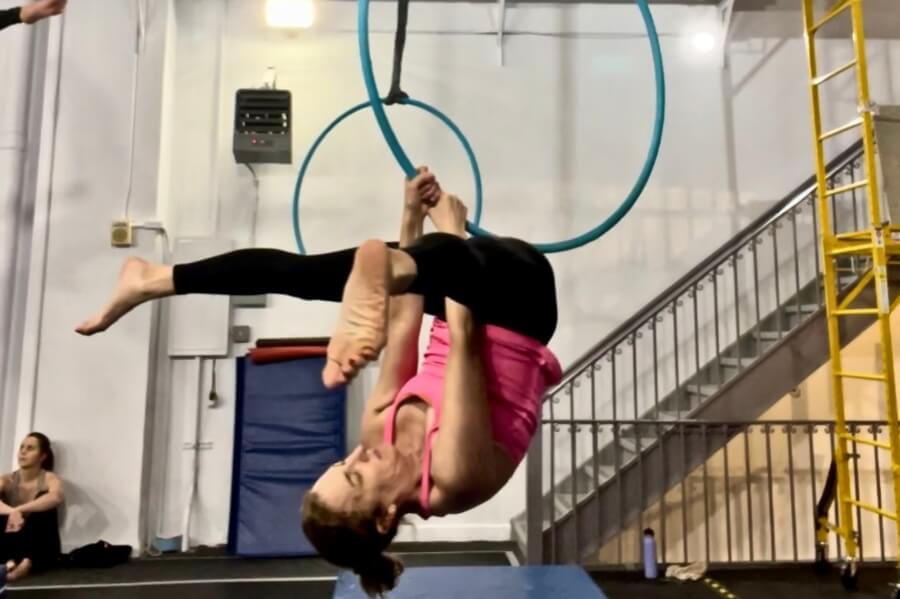
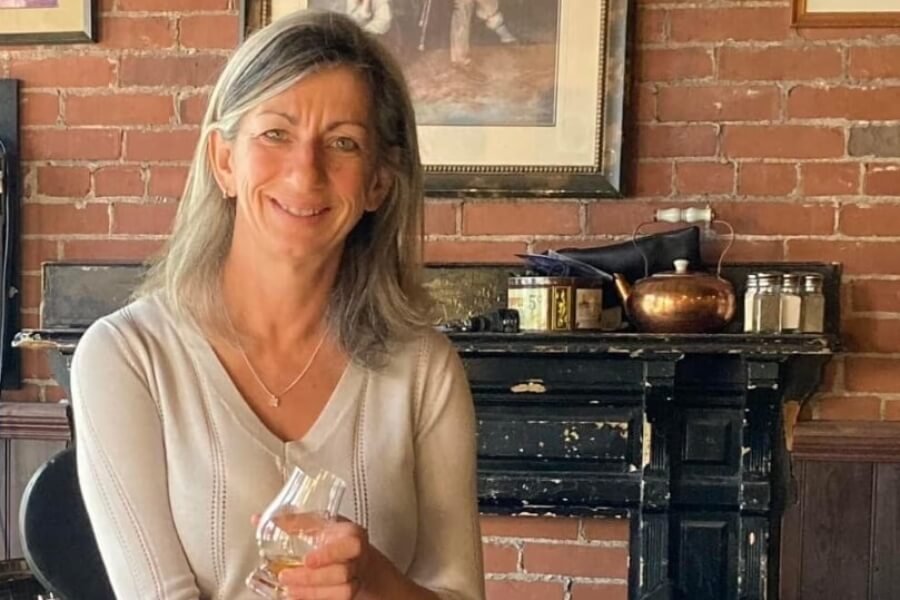


0 Comments